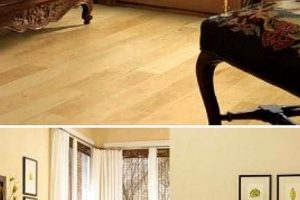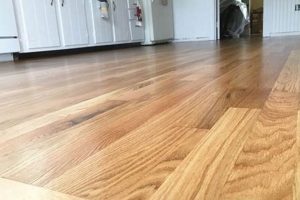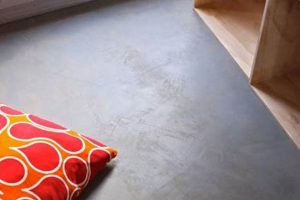Floors comprised of a hardened cement mixture, prepared for interior home use and enhanced with a surface treatment, represent a durable and customizable flooring option. These surfaces, common in modern construction and renovation, offer a seamless and often visually striking aesthetic alternative to traditional materials like carpet, tile, or hardwood. Consider a dwelling where the ground level features a continuous, polished gray expanse, creating a sense of openness and reflecting natural light. This illustrates the application of professionally treated cement-based flooring in a living space.
The implementation of this type of flooring provides several advantages, including longevity and ease of maintenance. The inherent strength of the cement material resists wear and tear, reducing the need for frequent replacement. Furthermore, routine cleaning requires minimal effort, contributing to long-term cost savings. Historically, this material was primarily utilized in industrial and commercial settings; however, advancements in surface treatments and design options have broadened its appeal for domestic applications. This shift reflects a growing preference for minimalist design and sustainable building practices.
The subsequent sections will delve into the various surface treatment options available, including polishing, staining, and sealing, and their impact on the final appearance and performance. Furthermore, the discussion will explore the installation process, cost considerations, and design possibilities associated with incorporating such flooring into homes.
Guidance on Integrating Cement-Based Interior Flooring
The following guidelines provide essential considerations for the successful integration of professionally treated cement-based flooring in homes, ensuring durability, aesthetic appeal, and long-term satisfaction.
Tip 1: Substrate Preparation is Paramount. Prior to the application of any surface treatment, the concrete slab must be thoroughly cleaned, leveled, and free from contaminants. Improper preparation can lead to adhesion issues, cracking, and uneven coloring.
Tip 2: Select Appropriate Sealants. The choice of sealant should be based on the intended use of the space and the desired level of protection. Epoxy sealants offer high durability and chemical resistance, while acrylic sealants provide a more economical and environmentally friendly option for low-traffic areas.
Tip 3: Consider the Environmental Impact. Cement production contributes to carbon emissions. Explore options like using fly ash concrete or sourcing materials from local suppliers to minimize the environmental footprint.
Tip 4: Understand the Curing Process. Proper curing is crucial for concrete strength and durability. Implement a consistent curing schedule, maintaining adequate moisture levels to prevent premature drying and cracking.
Tip 5: Incorporate Radiant Heating Strategically. If radiant floor heating is desired, it should be integrated during the initial slab pour to ensure even heat distribution and prevent damage to the finished surface.
Tip 6: Plan for Expansion Joints. Implement expansion joints strategically to accommodate thermal expansion and contraction, mitigating the risk of cracking due to temperature fluctuations.
Tip 7: Address Moisture Migration. Implement a vapor barrier beneath the concrete slab to prevent moisture migration from the soil, which can damage the surface and promote mold growth.
These guidelines, when followed, promote the longevity and aesthetic appeal of cement-based flooring in residential settings, providing a durable and visually striking surface for years to come.
The subsequent section will address the aesthetic considerations, including color selection, texturing techniques, and design integration strategies to complement diverse architectural styles.
1. Durability
Durability constitutes a fundamental characteristic of cement-based flooring in residential environments, significantly impacting its long-term value and performance. The inherent strength of concrete, when properly mixed and cured, provides a resilient base that resists wear, impact, and abrasion. This resistance translates to a longer lifespan compared to many other flooring materials, reducing the need for frequent replacement and minimizing lifecycle costs. For instance, in a high-traffic area such as a residential entryway or kitchen, a durable cement-based floor can withstand constant foot traffic, dropped objects, and spills without exhibiting significant signs of damage, unlike softer alternatives such as carpet or linoleum.
The level of durability in cement-based residential flooring is directly influenced by several factors, including the concrete mix design, the quality of the installation process, and the type of sealant applied. A mix design incorporating a higher cement content and appropriate aggregates will generally yield a stronger and more durable slab. Skilled installation practices, such as proper subgrade preparation and adequate curing, are essential to prevent cracking and ensure long-term structural integrity. Furthermore, the application of a high-quality sealant, such as an epoxy or polyurethane coating, provides an additional layer of protection against moisture, stains, and abrasion, further enhancing durability. Consider a residence with pets; a properly sealed surface will resist scratches from claws and stains from accidents.
In summary, the connection between durability and cement-based flooring in residential settings is critical. A focus on durability ensures a longer lifespan, reduced maintenance, and improved overall value. Challenges remain in selecting appropriate materials and installation techniques to maximize this characteristic. However, by prioritizing durability, homeowners can create a resilient and aesthetically pleasing flooring solution that withstands the demands of daily life while contributing to the long-term sustainability of the building.
2. Aesthetics
Aesthetics represent a pivotal consideration in the selection of cement-based flooring for residential applications. The visual appeal of the flooring directly influences the overall ambiance and design coherence of a living space. The surface finish presents numerous customizable options, extending far beyond the utilitarian perception traditionally associated with concrete.
- Color Integration
Color plays a crucial role in shaping the aesthetic of professionally treated cement-based flooring. Integral color additives, stains, and dyes enable the creation of a wide spectrum of hues, allowing for seamless integration with existing design schemes. For instance, a neutral gray tone can complement a minimalist interior, while a warmer earth tone can enhance a rustic aesthetic. Improper color selection can visually clash with the interior decor. This demonstrates the importance of carefully considering color during the design phase.
- Textural Variations
Textural elements add depth and visual interest to cement-based flooring. Techniques such as polishing, texturing, and the incorporation of aggregates allow for the creation of smooth, matte, or subtly textured surfaces. A highly polished surface offers a sleek and modern look, while a lightly textured surface provides enhanced slip resistance and a more natural feel. An over-textured floor can be difficult to maintain and visually overwhelming. The proper selection of texture impacts both aesthetics and functionality.
- Decorative Enhancements
Decorative enhancements offer further customization possibilities, transforming a plain surface into a unique design statement. Stencils, scoring, and the integration of inlays, such as glass or metal, allow for intricate patterns and personalized designs. Scoring creates defined lines and geometric patterns, while stencils allow for the application of complex designs. The excessive use of decorative elements can appear cluttered and detract from the overall aesthetic. A balance between simplicity and visual interest is key.
- Surface Sheen
The level of surface sheen significantly impacts the overall aesthetic of cement-based flooring. A high-gloss finish reflects light, creating a bright and contemporary feel, while a matte finish offers a more subtle and understated look. A high-gloss finish requires frequent cleaning to maintain its shine, while a matte finish is more forgiving of minor imperfections. The choice of sheen should align with the desired aesthetic and the maintenance capabilities of the homeowner.
Collectively, these aesthetic considerations highlight the versatility of professionally treated cement-based flooring in residential settings. By carefully selecting colors, textures, decorative enhancements, and surface sheens, homeowners can create a visually appealing and personalized flooring solution that complements their individual design preferences. The mindful integration of these elements is essential for achieving a harmonious and aesthetically pleasing interior.
3. Maintenance
Sustained visual appeal and longevity of cement-based flooring in residential settings are intrinsically linked to diligent maintenance practices. Routine care not only preserves the aesthetic qualities but also contributes to the long-term structural integrity of the flooring material. The following outlines crucial facets of maintenance protocols that ensure optimal performance and minimize the need for costly repairs.
- Regular Cleaning Protocols
Routine cleaning forms the cornerstone of cement-based floor care. Dust, debris, and spills should be promptly removed to prevent surface abrasion and staining. A microfiber mop or soft-bristled broom, coupled with a pH-neutral cleaner, is recommended for daily or weekly cleaning. Abrasive cleaners and scouring pads should be avoided, as they can damage the sealant and dull the surface. For instance, a kitchen floor subjected to frequent spills requires more frequent cleaning compared to a bedroom floor.
- Sealant Application and Reapplication
The sealant acts as a protective barrier, preventing moisture penetration and staining. The type of sealant employed dictates the frequency of reapplication. Acrylic sealants generally require more frequent reapplication (every 1-2 years) compared to epoxy or polyurethane sealants (every 3-5 years). The sealant selected will depend on the budget. Regular inspection for signs of wear, such as dullness or water absorption, is critical. A timely sealant reapplication preserves the floor’s integrity and appearance.
- Stain Prevention and Removal
Preventative measures, such as the prompt removal of spills and the use of mats in high-traffic areas, minimize the risk of staining. Certain substances, such as acidic liquids (vinegar, lemon juice) and dyes, can penetrate the sealant and cause discoloration if left unattended. If staining occurs, specialized stain removers designed for cement-based surfaces should be used according to the manufacturer’s instructions. Aggressive scrubbing or the use of harsh chemicals should be avoided.
- Crack Prevention and Repair
While cement-based floors are durable, cracking can occur due to subgrade settlement, thermal expansion, or excessive loads. Preventative measures include proper subgrade preparation, the installation of expansion joints, and avoiding overloading the floor with excessively heavy objects. Minor cracks can be repaired with cement-based patching compounds or epoxy fillers. Larger cracks may require professional intervention. Timely crack repair prevents further damage and maintains the structural integrity of the flooring.
Adherence to these maintenance protocols significantly extends the lifespan and enhances the aesthetic qualities of professionally treated cement-based flooring in residential environments. Consistent care and preventative measures minimize the need for extensive repairs, providing a cost-effective and visually appealing flooring solution for homeowners. This contributes to the overall value and enjoyment of the living space.
4. Installation
The installation process directly determines the long-term performance and aesthetic quality of professionally treated cement-based flooring in residential settings. Deficiencies during installation, such as inadequate subgrade preparation or improper mixing of the concrete, precipitate cracking, uneven surfaces, and premature wear. For example, if a concrete slab is poured over an unstable or poorly compacted subgrade, settling can occur, leading to cracks that compromise both the structural integrity and visual appeal of the floor. Therefore, a meticulous installation process is not merely a step in creating the floor; it is a foundational element determining the durability and eventual success of the entire flooring system.
The intricacies of the installation process involve several critical stages: subgrade preparation, concrete mixing and pouring, curing, and surface finishing. Subgrade preparation entails ensuring a stable, level, and well-compacted base. Concrete mixing requires precise adherence to mix designs, utilizing appropriate ratios of cement, aggregate, and water. Proper pouring techniques are necessary to ensure uniform distribution and minimize air pockets. Curing, a process of maintaining moisture levels, is critical for the concrete to achieve its maximum strength. Surface finishing involves grinding, polishing, and sealing the surface to achieve the desired aesthetic and protective qualities. Consider a scenario where the concrete is not properly cured: the resulting floor would be prone to cracking and dusting, diminishing its lifespan and requiring costly repairs. The installation stage is the most important process to consider to get a good and durable floor.
The significance of proper installation extends beyond immediate aesthetic considerations. A well-installed cement-based floor contributes to the overall energy efficiency of a home by providing thermal mass, which helps to regulate temperature fluctuations. Additionally, a properly sealed surface resists moisture and inhibits mold growth, contributing to a healthier indoor environment. Understanding the crucial link between installation and the long-term success of residential cement-based flooring enables informed decision-making regarding contractor selection, material choices, and adherence to best practices. This understanding also facilitates proactive maintenance strategies, further extending the lifespan and maximizing the value of this flooring option.
5. Cost
The economic dimension of professionally treated cement-based flooring in residential settings is multifaceted, encompassing initial investment, long-term maintenance expenses, and potential value appreciation. Understanding these elements is crucial for homeowners evaluating flooring options and budgeting for construction or renovation projects.
- Material and Installation Expenditures
Initial costs vary significantly based on the scope of the project. Concrete slab preparation, material selection (including color additives, aggregates, and sealants), and labor charges all contribute to the overall expense. Unlike readily installed materials like carpeting, placement of concrete requires professional expertise and specialized equipment. This demands a higher upfront investment, but offers an extended service life.
- Surface Treatment and Finishing Costs
Surface treatments, such as polishing, staining, and sealing, impact the final cost. Polishing, involving multiple grinding stages, typically increases expenses. Premium sealants, offering superior stain resistance and durability, also contribute to higher upfront expenditures. Selection of lower-quality materials will reduce costs in the short run but will increase maintenance costs later on.
- Maintenance and Repair Outlays
Routine maintenance involves regular cleaning and periodic sealant reapplication. While daily maintenance is typically low-cost, sealant reapplication requires professional expertise and material expenditures. Unexpected repairs, such as crack remediation, can incur substantial costs if not addressed promptly. Early detection of damages saves money.
- Long-Term Value and Resale Potential
Professionally installed and well-maintained cement-based flooring enhances property value, making it an attractive selling point. Durability and contemporary aesthetics can appeal to prospective buyers. While the initial investment might be higher compared to some alternatives, the long-term value proposition and resale potential can offset these costs.
Collectively, these cost-related facets underscore the importance of a comprehensive financial evaluation when considering cement-based flooring for residential applications. By carefully assessing initial expenditures, surface treatment costs, maintenance outlays, and long-term value, homeowners can make informed decisions that align with their budgetary constraints and design aspirations. Ignoring any of these factors can result in financial hardship and buyer’s remorse.
6. Sustainability
The increasing focus on environmentally responsible building practices has amplified the importance of sustainability within the context of cement-based flooring in residential settings. This involves evaluating the environmental impact of material selection, production processes, installation techniques, and the flooring’s lifespan and end-of-life management.
- Material Sourcing and Composition
The sustainability of cement-based flooring hinges significantly on the source and composition of its constituent materials. Traditional cement production is energy-intensive and contributes to greenhouse gas emissions. Utilizing supplementary cementitious materials (SCMs) like fly ash, slag, or silica fume can reduce the cement content, thereby lowering the carbon footprint. Sourcing aggregates locally reduces transportation emissions. Prioritizing recycled content and regionally available resources minimizes environmental impact.
- Energy Efficiency and Thermal Mass
Cement-based floors possess inherent thermal mass properties, enabling them to absorb and release heat, contributing to passive heating and cooling within a residence. This reduces the reliance on mechanical heating and cooling systems, translating to lower energy consumption and associated emissions. Integration with passive solar design principles further enhances energy efficiency. Optimizing insulation around the perimeter of the slab minimizes heat loss, maximizing thermal performance.
- Indoor Air Quality
The selection of low-VOC (volatile organic compound) sealants and finishes is crucial for maintaining healthy indoor air quality. Traditional sealants can release harmful chemicals that negatively impact respiratory health. Opting for water-based or low-VOC alternatives minimizes these risks, contributing to a healthier living environment. Proper ventilation during installation and curing further reduces exposure to residual emissions.
- Durability and Longevity
The inherent durability and extended lifespan of cement-based flooring directly contribute to its sustainability. A longer service life reduces the frequency of replacement, minimizing resource consumption and waste generation. Proper maintenance and timely repairs further extend the flooring’s lifespan, optimizing its environmental performance. Selecting a durable, long-lasting floor is more sustainable than replacing lower-cost, less durable options more frequently.
These interconnected aspects of sustainability highlight the potential of professionally treated cement-based flooring to contribute to environmentally conscious residential construction. By prioritizing responsible material sourcing, energy efficiency, indoor air quality, and durability, homeowners and builders can minimize the environmental footprint and create healthier, more sustainable living spaces. A life-cycle assessment is the most thorough method to evaluate the sustainability of cement-based flooring relative to other options.
Frequently Asked Questions
The following addresses prevalent inquiries regarding cement-based flooring in residential environments, clarifying misconceptions and providing informative answers to common concerns.
Question 1: Are cement-based floors inherently cold?
While cement-based floors can feel cooler to the touch compared to carpet or wood, this is due to the material’s thermal conductivity, not an inherently cold temperature. Proper insulation beneath the slab and the incorporation of radiant heating systems mitigate this perceived coolness.
Question 2: Are these types of floors susceptible to cracking?
Cracking can occur if proper installation protocols are not followed. Adequate subgrade preparation, proper joint placement, and controlled curing processes minimize the risk of cracking. Hairline cracks are common but do not typically compromise structural integrity.
Question 3: How do cement-based floors compare in cost to other flooring options?
The initial cost can be comparable to or slightly higher than mid-range flooring options like tile or hardwood, depending on the complexity of the design and surface treatments. However, the long-term durability and low maintenance requirements can result in lower lifecycle costs.
Question 4: Are cement-based floors difficult to maintain?
Maintenance is generally straightforward. Regular sweeping or mopping with a pH-neutral cleaner is sufficient for routine cleaning. Periodic reapplication of sealant is required to maintain stain resistance and protect the surface.
Question 5: Can cement-based floors be used in bathrooms and kitchens?
Yes, these floors are suitable for bathrooms and kitchens. Proper sealing is crucial to prevent water damage and staining in these moisture-prone areas. Textured finishes enhance slip resistance in wet environments.
Question 6: Are there limitations to color and design options?
Cement-based floors offer extensive design flexibility. Integral color additives, stains, dyes, and decorative techniques allow for a wide range of aesthetic possibilities. However, achieving consistent color throughout a large area requires careful planning and skilled execution.
These FAQs provide clarity on critical aspects of cement-based residential flooring, assisting homeowners in making informed decisions.
The succeeding section will explore case studies showcasing successful applications of cement-based flooring in diverse residential settings.
Concluding Summary
The preceding discourse has elucidated the multifaceted nature of “finished concrete floors residential”, encompassing aspects of durability, aesthetics, maintenance, cost, and sustainability. The analysis has underscored the importance of meticulous installation practices, informed material selection, and diligent maintenance protocols in ensuring the longevity and aesthetic appeal of this flooring option. Furthermore, the exploration has revealed the potential for customization, enabling homeowners to tailor the flooring to complement diverse architectural styles and design preferences.
The increasing emphasis on sustainable building practices and the growing demand for durable, aesthetically versatile flooring solutions position “finished concrete floors residential” as a compelling option for homeowners. Continued advancements in concrete technology and surface treatment techniques promise further enhancements in performance, design possibilities, and environmental responsibility. Careful consideration of these factors will enable informed decision-making, maximizing the value and minimizing the potential challenges associated with this flooring choice.







